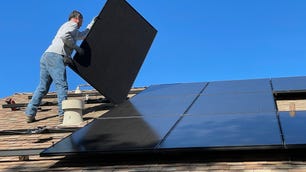Photo voltaic farms can develop extra than simply clear vitality. They could be a cradle for a struggling however important inhabitants: pollinators.
To keep away from the worst results of local weather change, we have to cease burning the fossil fuels which might be warming the planet and quickly transition to carbon-free types of vitality like photo voltaic, wind and geothermal.
In the meantime, local weather change, together with habitat loss and pesticide use, is inflicting populations of pollinator bugs to crash, imperiling vegetation, together with some vegetation people use for meals. Some estimates put the speed of decline at about 2% per yr or 45% over the past 40 years.
There’s hope that efforts to unravel one drawback may assist with the opposite: Current analysis by scientists on the Argonne Nationwide Laboratory discovered that the aware design of photo voltaic farms may help reverse the decline of pollinators. In Minnesota, two photo voltaic websites planted with native vegetation had their pollinator populations triple in simply 4 years.
The outcomes “inform us that it’s achievable and you’ll see fairly fast outcomes on the photo voltaic websites inside 4 years or so,” stated Lee Walston, an ecologist at Argonne Nationwide Laboratory and an creator of the revealed analysis.
Watch this: The Ocean Cleanup’s System 03 Collects Plastic Air pollution at Document Ranges
08:53
The issue for pollinators

Insect pollinators (not all pollinators are bugs) are on the decline for a number of causes, together with local weather change. Pesticides used to kill pest bugs may also kill useful ones. Land improvement that turns appropriate habitats into roads, lawns, parking tons and buildings reduces the meals and habitat accessible to bugs. On the similar time, invasive species outcompete native species and new ailments cut back populations additional.
Because the local weather modifications thanks largely to emissions from burning fossil fuels, vegetation some bugs depend on could bloom too early or shift their vary looking for cooler temperatures, leaving the bugs with out a meals supply and the plant with out a pollinator.
About one out of each 10 species of bee and butterfly in Europe are threatened with extinction, in keeping with the European Union. The variety of bumblebees in america has decreased by 50% since 1974, in keeping with the US Fish and Wildlife Service. Even in some comparatively undisturbed forests, US Forest Service scientists discovered that the variety of bees and butterflies declined by 60% over 15 years.
Issues for pollinators may translate into issues for individuals, too. Analysis revealed in 2022 discovered that declining populations of pollinators and the ensuing decline in crop manufacturing may contribute to greater than 400,000 untimely deaths annually. Pollinators add billions of {dollars} to the financial system annually.
How photo voltaic farms could make room for pollinators
The 2 photo voltaic installations the Argonne scientists studied had been previously working farmlands that had been then stuffed with photo voltaic panels and native vegetation. Pollinators got here flooding again with the reappearance of vegetation that present habitat and meals.
Over the examine each the quantity and kind of flowering vegetation and bugs elevated, with some varieties greater than tripling. There have been twenty instances extra native bees current on the photo voltaic installations on the finish of the 4 years.
In 2024, these aren’t new outcomes, however they match the findings of different research.
“We noticed that inside these different research there have been fairly speedy responses. Inside 5 years you seen a giant enhance in that plant group and a giant enhance within the pollinator group,” Walston stated. “Our outcomes kind of slot in with that.”
That timeline is prone to range primarily based on area. Whereas 5 years suits a typical timeline for the area, hotter, drier areas may take longer, Walston stated.
Photo voltaic farms on farmland
Massive-scale photo voltaic installations on agricultural land have been one thing of a flashpoint not too long ago, with native opposition stopping particular person initiatives or barring such developments wholesale. It is a problem that makes attaining local weather targets tougher.
Photo voltaic installations could require 10 million acres, or 0.5% of the nation’s floor space by 2050, in keeping with a 2021 report from the US Division of Power. The identical report says disturbed lands (a class that features developed areas and areas impacted by invasive species) make up 8% of the contiguous 48 state’s floor space, whereas agricultural land makes up 43%. Paved and concrete areas (that embrace a whole lot of rooftops) make up one other 5%.

Photo voltaic panels surrounded by native vegetation are good for pollinators.
Photo voltaic builders more and more must grapple with native opposition to photo voltaic improvement, however the researchers on this examine discovered a useful spillover impact from photo voltaic and native plant websites.
“We additionally see elevated pollinator visits to adjoining farmland,” Walston stated. “The photo voltaic websites may present habitat that might enhance the pollination service to adjoining farmland.”
Surrounding photo voltaic panels with vegetation could make photo voltaic panels extra productive, too. Vegetation creates a cooler microclimate round photo voltaic panels, in comparison with naked floor or pavement. Photo voltaic panels are extra environment friendly after they’re cool.
With simply minimal upkeep necessities — mowing and restricted herbicide use — the solar-with-native-plants mannequin is one approach to set up photo voltaic panels that not solely avoids harming biodiversity but additionally helps it.
“There’s a whole lot of alternative to offer a web profit with habitat enhancement at these websites,” Walston stated.
https://www.cnet.com/movies/the-ocean-cleanups-system-03-collects-plastic-pollution-at-record-levels/




















